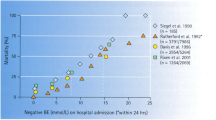Abstract
Inspired by the Stewart-Figge acid–base approach, Gattinoni et al. recently introduced a new internal milieu parameter known as alactic base excess (ABE). The authors defined ABE as the sum of lactate and standard base excess. In the context of sepsis, ABE has been proposed as a valuable marker to discern between metabolic acidosis resulting from the accumulation of lactate and the retention of fixed acids, which can occur in cases of renal failure. Multiple studies have demonstrated that a negative ABE value (<−3 mmol/L) represents an early marker of renal dysfunction, and significantly correlates with higher mortality rates in septic patients. In conclusion, ABE is a simple and useful parameter that can be used to better interpret a patient’s acid–base status, assess renal function, and general prognosis in sepsis. By incorporating ABE into clinical practice, healthcare professionals can enhance their understanding of the complex acid–base imbalances in their patients and tailor more individualized, effective treatment plans.
Similar content being viewed by others
References
Cantos J, Huespe IA, Sinner JF, Prado EM, Roman ES, Rolón NC et al (2023) Alactic base excess is an independent predictor of death in sepsis: a propensity score analysis. J Crit Care 74:154248
Gunnerson K, Saul M, He S, Kellum J (2006) Lactate versus non-lactate metabolic acidosis: a retrospective outcome evaluation of critically ill patients. Critical care (London, England) 10:R22
Musso CG, Cordoba JP, Aroca-Marinez G, Terrasa S, Barriga-Moreno AP, Lozano-Sanchez M et al (2022) Negative alactic base excess is reversed by hemoperfusion in septic patients. G Clin Nefrol Dial 34:122–124
Gucyetmez B, Atalan HK (2016) Non-lactate strong ion difference: a clearer picture. J Anesth 30(3):391–396
Figge J, Bellomo R, Egi M (2018) Quantitative relationships among plasma lactate, inorganic phosphorus, albumin, unmeasured anions and the anion gap in lactic acidosis. J Crit Care 44:101–110
Musso CG, Vilas MF (2019) Water, electrolyte, and acid-base disorders in the elderly. In: Musso CG, Jauregui JR, Macías-Núñez JF, Covic A (eds) Clinical nephrogeriatrics. Springer, Cham, pp 43–62
Gattinoni L, Vasques F, Camporota L, Meessen J, Romitti F, Pasticci I et al (2019) Understanding lactatemia in human sepsis. Potential impact for early management. Am J Respir Crit Care Med 200(5):582–589
Ratnam S, Kaehny W, Schapiro J (2011) Pathogenesis and treatment of metabolic acidosis and alkalosis. In: Schrier R (ed) Renal and electrolyte disorders. Wolters Kluwer, Philadelphia, pp 86–121
Gattinoni L, Carlesso E, Cadringher P, Caironi P (2006) Strong ion difference in urine: new perspectives in acid-base assessment. Crit Care 10(2):137. https://doi.org/10.1186/cc4890
Author information
Authors and Affiliations
Corresponding author
Ethics declarations
Conflict of interest
All the authors declare that they have no conflict of interest.
Additional information
Publisher's Note
Springer Nature remains neutral with regard to jurisdictional claims in published maps and institutional affiliations.
Rights and permissions
Springer Nature or its licensor (e.g. a society or other partner) holds exclusive rights to this article under a publishing agreement with the author(s) or other rightsholder(s); author self-archiving of the accepted manuscript version of this article is solely governed by the terms of such publishing agreement and applicable law.
About this article
Cite this article
Hoque, M., Nagourney, J., Pawlowski, T. et al. Alactic base excess (ABE): a novel internal milieu parameter—its concept and clinical importance. Int Urol Nephrol 56, 1983–1986 (2024). https://doi.org/10.1007/s11255-024-03949-2
Received:
Accepted:
Published:
Issue Date:
DOI: https://doi.org/10.1007/s11255-024-03949-2




